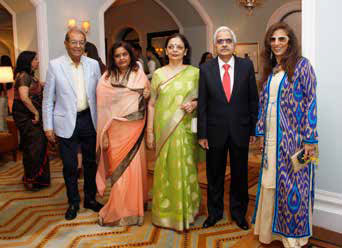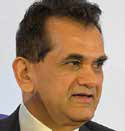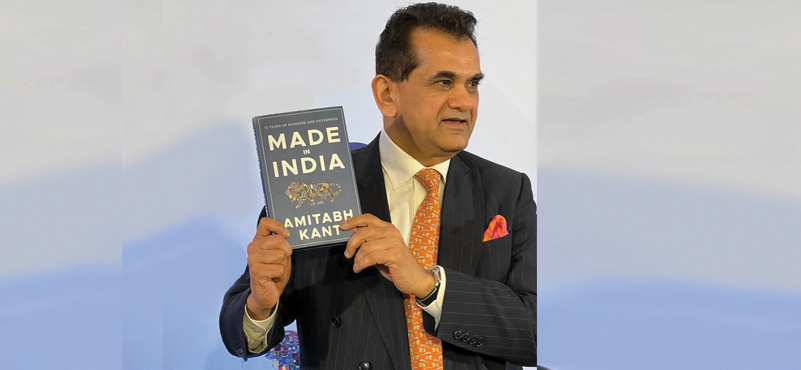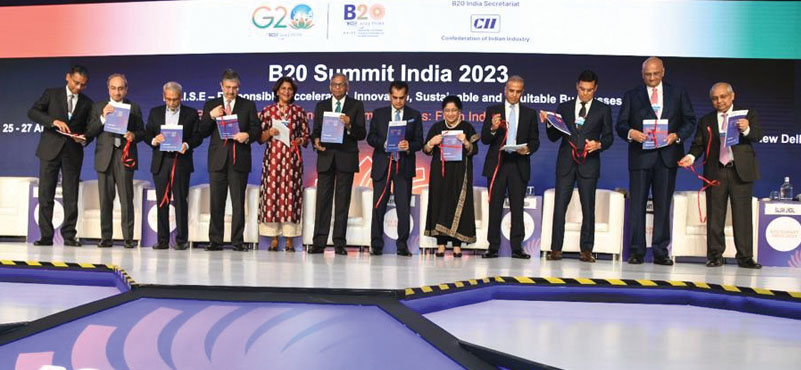The author, Amitabh Kant, has seen it all during the last decade, from heading the DIPP to Niti Ayog and now as PM’s Sherpa to the G20 summit. He argues that ‘Made in India’ is essentially about manufacturing for which we need companies with global size and scale. Kant started as collector Calicut, was then secretary Kerala Tourism, joint secretary in the Ministry of Tourism at the Centre; instrumental in promoting God’s Own Country and Incredible India, subsequently launching the Make In India campaign in Germany. Large scale manufacturing will help grow the MSME sector as well. The book was released in Delhi and Mumbai; both cities featured high celebrity events, witnessing the presence of industrialists, intelligensia, creative minds. Both cities featured a panel discussion on Trends in the Marketplace, providing food for thought towards a result-oriented future. we bring you excerpts from his presentations in both cities:
From the Delhi launch:
“Look at the history of 75 years from the point we got colonized. India was at about 24% of global GDP. By the time the British left us, we had just about 5% of global GDP. We moved from British Raj to License Raj, and we saw a huge stranglehold through licensing, industrial dispute act, labour laws, many other things. Now, the Indian private sector enterprise has grown and flourished despite all controls. And, I have been a long-term believer that if India has to grow at high rates of 8 to 9% per annum, year after year, three decades or more, India has to become a 5 trillion or 10 trillion economy. The private sector must be the wealth creator. No country in the world has grown on the back of public sector; the private sector, which must create wealth, and the government must be a facilitator, a catalyst, and has to work on education, health, and nutrition, and actually, bring in the right policy framework.
This book is about how the private sector must flourish in India and how the government must retreat in the vast range areas. It also brings in my experiences from 2014 when I was secretary, DIPT, on how we brought the Ease in Business.
The Prime Minister in his very first interactions had said we should just scrap all these rules, regulations, and procedures. And we jumped up 79 positions in the World Bank ‘ease of doing business’ ranking. We started making states compete with each other. And therefore, in a large country like ours, competition really moved, made things move forward. When we started startup India, there were just about 456 startups in India. Today there were 90,000 startups. There were 110 unicorns, and they have attracted a vast amount of capital, over about 340 billion worth of capital in India. And startups have done a huge amount of disruption, not nearly for India, but for the world.
And now we see this production linked incentive scheme really unleashing itself into manufacturing in a vast range of areas.
So, my belief is that India needs to fire on all cylinders, not nearly services, but also manufacturing, also agricultural productivity, also urbanization for it to grow on a large scale over a long period of time. At the time we had the strangle world of government, we saw many Asian countries growing during the period 1960 to 1990, Korea growing at about 9.6% consecutively. For three decades, Taiwan grew at the same period. Japan had grown in post-World War II period with those rates. And in recent times China has grown. But the period in which the time span within which they grew, while they were growing, they were also manufacturing and carbonizing the world. When India needs to grow at high rates of growth, there are many other challenges of integrating yourself with global supply chain and the challenges that the world has become far more inward-looking post covid, the challenges that India needs to be the first country in the world to industrialize without carbonizing.
And the challenge really is to become major, not nearly major manufacturers, but to penetrate global markets today. And only without becoming global, uh, globally competitive, and without becoming productively efficient, it will not be possible to do that. So, the book brings out all these lessons of different countries. It brings out all the challenges before India, and it really brings out how we need to technologically leap frog in many sunrise areas of growth. And once that happens, that unleashing of private sector, which is happening now. India will not only go on to become the third largest economy in the world, but also raise the per capita income of Indians very rapidly forward and become a highly developed nation. And therefore, many of the lessons of different countries are spelt out here and what India needs to do, learning from our own lessons and many of these things.”
From the Mumbai launch:
“If you look back at the years when India has really grown and India has grown at 8-9%, for four to five years, but it has not grown for, you know, decades like other countries have done. But every time we have done that, it is because our exports have grown. So, exports are the key to growth, really, and that really means that you need companies that will penetrate global markets. You need size and scale of manufacturing. And that is why we brought in the PLI scheme. The production linked incentive scheme was very simple. Many people mistake it for subsidy.

If you do not achieve your targets, you don’t get it. But in five years’ time, it gives you this opportunity to become global in size and scale. And once you have companies with that global size and scale, you will have two manufacturers, two three, like Maruti came in and all these MSMEs came in the automobile sector because of Maruti. It is an automatic backward forward linkage, and therefore you need large companies for MSMEs to grow. I think for large companies to happen in India, we also need to scrap many of the labour laws, which were made long time back. We need to decriminalize a lot, which the prime minister is pushing for.
So, a lot of that work is in action mode right now. And I think in the next two to three years, you will see India becoming more and more, more and more efficient in many of these areas to enable large size and scale. Look at a sector where India has the potential. I think to my mind, green hydrogen is the area where India has the potential. Today, the cost of producing green hydrogen is $4.50 per kilogram. India is the only country which is climatically blessed. It has top class entrepreneurship. It is possible for us to bring the cost down to $1 per kilogram, but it will not happen if we do not have the scale. And you can be the biggest producer and exporter to the world, but it will not happen without size and scale. So, size and scale are really the key to success.“
ABOUT THE AUTHOR
 Amitabh Kant is presently India’s Sherpa to G20 group, during a year when India holds its presidency. Kant is formerly a secretary in the Government of India, former CEO of Niti Ayog, and creator of globally acclaimed campaigns like ‘Incredible India’ for the Ministry of Tourism.
Amitabh Kant is presently India’s Sherpa to G20 group, during a year when India holds its presidency. Kant is formerly a secretary in the Government of India, former CEO of Niti Ayog, and creator of globally acclaimed campaigns like ‘Incredible India’ for the Ministry of Tourism.




































